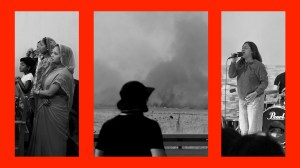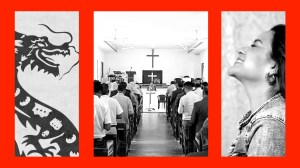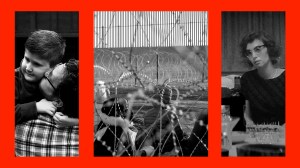In this series

We could tell by the calendar that 2024 was going to be a big year. We had a US presidential election, the Olympic Games, the launch of a new denomination, and a total solar eclipse. But plenty of the year’s top stories surprised us: a record-breaking hurricane ripping through Georgia and the Carolinas, a spurt of pastor scandals involving big names in Dallas, and bleak investigative reports involving some of the biggest denominations in the world.
The news team looked back at stories on megachurches and Methodists, athletes and assassination attempts, Haitian gangs and Gazan families, and ranked the developments we saw as the most significant for evangelicals and the church.
12. Violence in Haiti
Haitian pastors minister amid the escalating gang violence, deaths, civil unrest, and displacements that have uprooted their country. The evangelical president of Kenya deployed police and prayer to help.
11. Total Solar Eclipse
Christians came together to witness a total eclipse and celebrate this weird wonder of creation. Churches in the path of totality hosted scores of events—some with moon pies decorated with the promise of John 8:12, “Whoever follows me will never walk in darkness.” While the blacked-out sun turned some believers’ thoughts to apocalyptic portents, other Christians drew lessons about the light shining in the darkness.
10. Israel-Hamas War
The war in Gaza stretched into a second year, and evangelicals in the region struggled to be peacemakers amid the devastation. Many Israelis and Palestinians didn’t want to hear messages of peace, and those who preached peace couldn’t agree on what peace should mean in Israel. But Bible scholars worked to model good conversations. And Christians worked to find ways to love their neighbors—displaced Palestinians, displaced Israelis, and people on the border of Israel and Lebanon.
9. Federal Investigation of the SBC
The Department of Justice issued its first indictment in a years-long inquiry into abuse response within the Southern Baptist Convention (SBC), charging a former Southwestern Seminary professor with misleading investigators. The SBC is selling its Nashville headquarters after spending $12 million in legal fees related to its own abuse investigation.
8. Hurricane Helene
Hurricane Helene devastated the Southeastern United States in September, hitting the mountains of Western North Carolina particularly hard. Christian disaster organizations like Samaritan’s Purse that normally work overseas responded to what they saw as an unprecedented sweep of destruction in the area. When Asheville, North Carolina, had no clean water for weeks and weeks after the storm, Christian clean-water organizations brought in tanks of drinking water, technical expertise for wells, and treatment systems for public schools to reopen.
7. Summer Olympic Games
The Paris Olympics were a ratings success, drawing massive viewership compared to the previous summer Olympics. CT highlighted 28 Christian athletes from all over the world to watch at the games (including an interview with gold-medalist wrestler Kyle Snyder). Some highlights from the games included the Fijian Olympic team singing hymns together, a Brazilian skateboarder using sign language to share John 14:6, and a German shot-putter singing a gospel song after winning gold.
6. Church of England Scandals
The Church of England was roiled by evangelical abuse scandals. An independent investigation found that more than a dozen ministers knew for decades that an evangelical lay leader violently beat boys at a school and summer camp, but they failed to report it to authorities. Justin Welby, already dealing with controversy over statements about same-sex relationships, became the first Anglican archbishop to resign. In a separate case, an 81-year-old evangelical priest was charged with eight counts of indecent assault.
5. Legal Issues Around Abortion and IVF
Two years after the reversal of Roe v. Wade, Americans continued to see the legal landscape shift around abortion and assisted reproduction. Florida, South Dakota, and Nebraska became the first states to vote against statewide protections for abortion. Alabama ruled that embryos stored for in vitro fertilization count as children under the law, based on its constitutional protections for the unborn.
4. The Founding of the Global Methodist Church
Hundreds gathered in Costa Rica this year to found a new denomination with prayers, tears, and debates about dancing bishops. The Global Methodist Church gives traditionalists a fresh start, thanks in part to Keith Boyette, the pastor-lawyer who helped them find their way out of the United Methodist Church. The new denomination appears to be part of a surge of interest in Wesleyan renewal. As one seminary professor noted, “Wesley is fire now.”
3. Megachurch Scandals in Dallas
The sudden resignation of pastor and best-selling author Tony Evans from his megachurch was the beginning of a summer of at least eight megachurch pastor resignations in the Dallas–Fort Worth area. Robert Morris, the founder of Gateway Church, one of the largest megachurches in the country, resigned in June after a report alleging he abused a 12-year-old in the 1980s. The resignations were largely over sex scandals and affected at least 50,000 churchgoers.
2. Attempted Assassinations of Donald Trump
The 2024 US election was upended by a number of twists and turns, including two assassination attempts directed at Donald Trump. During the first attempt, at a rally in Butler, Pennsylvania, a bullet grazed the candidate’s ear. Trump would later say he believed God protected him, a belief some of his supporters also expressed. The shooting resulted in multiple injuries and the death of one rally goer, Corey Comperatore. The campaign returned to Butler less than three months later for a rally, which provoked locals to pray for his protection.
1. Polarization and Anger Around the 2024 Election
The United States reelected Donald J. Trump to the presidency. His path to victory again ran through the church, though he also expanded his support among multiple demographics. The election was a polarizing one, and Christian poll workers faced increased vitriol. Christian groups addressed polarization head-on through hard conversations, and counselors brought attention to a growing number of Christians struggling with rage and anger.































































































